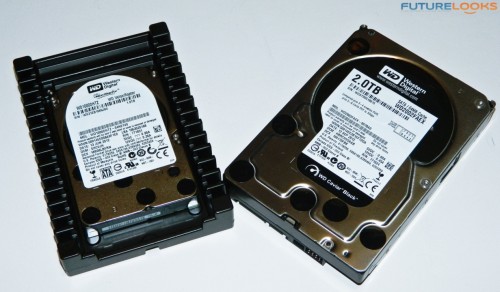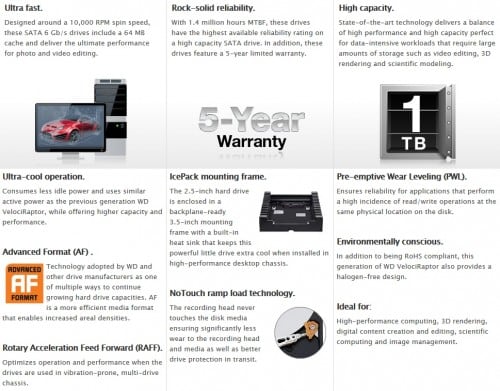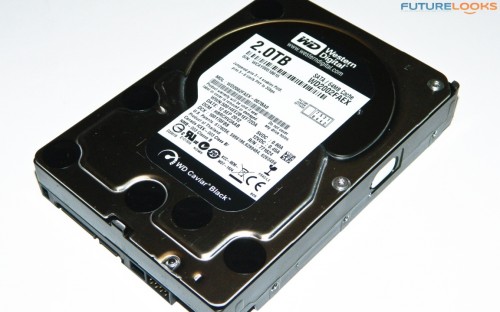In the past couple years, Intel has said that SSDs will inevitably replace platter based hard drives. Unfortunately, limited quantities of expensive NAND and controllers are one aspect preventing that from happening. The second obstacle is that SSDs just aren’t available in large enough capacities to satisfy consumers. The only way that Intel prediction comes to fruition is if Intel takes the lead by pushing costs down and capacities up. While the SSD industry continues to trudge at a snail’s pace, 1TB and 2TB hard drives remain the popular consumer choice for both amount of storage and performance. Today, we’re looking at two of the fastest from Western Digital: The 1TB Velociraptor and the 2TB Black.
Western Digital 1TB Velociraptor (WD1000DHTZ)
At first glance, the Velociraptor looks just as big as any other regular hard drive. But the actual size of the hard drive is smaller than the connected composite adapter, or IcePack mounting frame. The black Velociraptor-adapter almost looks like a giant heat sink which would have been kind of cool, but it doesn’t exactly transfer heat like a heat sink. It’s actually there more as an adapter allowing this thick 2.5 inch drive to fit into a standard 3.5″ hard drive bay. Closer inspection reveals that the adapter is hard wired to the drive and can’t be removed.
Since many enclosures hide hard drives, it’s almost a shame that the Icepack doesn’t come in color options. Something like this would make it really stand out in a crowd.
Western Digital Velociraptor Series Features
When looking over engineering attributes, my favorite feature WD hard drives offer is the No-Touch ramp load technology. Basically, the recording head never touches the platter which cuts way down on head and platter wear. Naturally, the motor of course plays a significant roll. It’s these two components that make or break the reliability of any hard drive.
With high quality materials used to assemble each and every drive, each HDD should live up to their 5 year warranty.
Western Digital Black 2TB (WD2002FAEX)
When it comes to storage, size matters. The older generation WD 2TB I have in my media server has been an excellent and quiet work horse serving a few different game and media HTPCs. If the revised 2TB Black WD2002FAEX model is of the same stock, then it too should be super quiet as well as offering a decent amount of speed too.
Engineering wise, my previous generation WD Black 2TB (WD2001FASS) of 3 years (going on 4) utilized an LSI controller which is not a bad option at all. The new drive hides the controller away on a much more discreet mini PCB board. One of the neatest saving graces about any platter drive that simply stops responding is that the little board can be swapped out with a new one and often work enough to get data off.
However, if your HDD is making a racket when it decides to go out, it’ll need more than that to rescue the data trapped on it. But so far so good with my long term live in tester and the new features of this latest revision should extend life even further.
Western Digital 2TB Black Features
Again, wear leveling is minimized by the NoTouch Ramp Load technology. Its design eliminates vibrations which I can personally vouch for that it works. During preliminary inspection, the WD Black was extremely cool to the touch, which had me occasionally wondering if the drive was operating at all.
In terms of value adds, Acronis Software is included in the retail boxed SKU which is super handy for imaging over your existing hard drive to the new WD Black hard drive. This means, there is no need to reinstall Windows which is just fine assuming your current drive is problem free to begin with. If it’s starting to fail, then this won’t help you avoid catastrophe anyway.
Common Specifications and Pricing
Presently, Western Digital offers Blue, Green, Black, Red, and the Velociraptor model hard drives for SATA ports. Each flavor comes in similar capacities (but varying warranty lengths as per the chart above). The Blue is the price conscious solution, Green the standard desktop solution, Black for the performance solution, Red designed for RAID or NAS configurations, and Velociraptor because regular performance just isn’t enough for power users. WD also offers enterprise worthy drives in their RE series (not shown) with premium pricing, however, they have also released a new series called the “SE” (not shown) that sits between the enterprise and consumer price points.
Pricing for the WD 1TB Velociraptor (WD1000DHTZ) sits at an MSRP of $299.99 US, however, street price has it going for as low as $218.99 US. While that seems like a lot of money, it’s a rather large capacity wrapped around a 10K motor with a 5 year warranty.
The 2TB WD Black is massively excellent for more considerable backup available for as little as $155.99 US with a new 4TB WD Black available for as low as $276.36 US. A 1TB edition is also available for as low as $84.99 US.
Test System Setup
For this test, I’m using the same system from the Intel Haswell launch.
- Processor: Intel Core i7-4770K Haswell
- Motherboard: Intel DZ87KLT-75K Extreme
- Memory: Kingston HyperX 2400MHz DDR3 8GB (Dual Channel)
- Graphics: NVIDIA GTX 760
- Storage 1: Western Digital 1TB Velociraptor HDD (as tested)
- Storage 2: Western Digital 2TB Black (as tested)
- Power: Corsair HX750 Professional
- Cooling: Thermaltake Water 2.0 Extreme
- OS: Windows 7 Pro
The latest BIOS and Intel chipset driver is installed for best results.
Chipset performance differences look more pertinent on paper than in actual tests. Intel hasn’t really implemented any shock-and-awe SATA controller improvements over the last few generations. Performance differences through the chipsets won’t vary too much if any so you can expect similar results. Keep that in mind when comparing your P67, Z68 or Z77 system to the new Z87 platforms.
If you want to read more in regards to performance of the Haswell processor, check out our review. Otherwise, read on to check out the WD 1TB Velociraptor’s performance.
Performance Benchmarks
We’ve seen SSDs really transform what seemed like a slower system in to a racing machine. For that reason, we started off with PCMark7. Then, CrystalDiskMark was used to reveal the hard drives’ controller strengths and weaknesses especially when managing 4K data blocks which constitute the bulk of all kinds of software like video games, large office apps, and media files. ATTO rounds off the testing by looking at IO performance should you feel inclined to use these in an array.
The final test includes Windows boot and program load times. 8GB of memory will ensure plenty of space to cache data giving the Velociraptors a test of its full range of performance when we stick them in a two drive RAID 0 array.
PCMark7
Well, the extra RPMs do give the Velociraptor some extra crunching power. It may not seem like much, but it’s enough to enhance system performance which was more visible in the real world Windows boot and program load times.
CrystalDiskMark
Individual Velociraptors are capable of doubling the 4K data block performance compared to other Western Digital and Seagate based hard drives. Granted, it’s not the same animal as a 120GB SSD but the SSD is far from capable of storing 1TB of data. In RAID 0, the bandwidth increases by about 40% to 5.4MB/s which doesn’t seem like much till you start opening some larger programs. Then you appreciate the speed.
ATTO
IO performance puts the Velociaptors in a different light. These numbers reveal why the drives are seemingly so responsive compared to other hard drives. They’re simply quicker at locating and delivering the data requested. RAID 0 showed the two capable of 142MB/s write and 121MB/s read 4K performance. The gains were about 60% higher with larger IO tests. Like most platter RAID configurations, you’ll see the most performance out of 4 and a minuscule jump if using 5.
Boot Time (with Program Launches)
Windows boot times are better with Velociraptors. Individually, the drive manages to shave about 12 seconds versus similar drives. In RAID 0, it’s only a few more seconds less. Program load times improve as well.
What’s That Sound?
During various parts of testing, I noticed some mechanical noise coming from the Velociraptor hard drives. When they were bogged down with a heavy load like a large multi-GB transfer, I could hear a familiar repetitive rattle as the heads do their work. However, it wasn’t always constant. During regular system use, the drives weren’t that detectable especially inside the computer enclosure. Additionally, the higher RPMs resulted in some extra drive chassis heat but nothing a little air flow couldn’t handle. Since most enclosures have fans at the front, they should be just fine.
There was very minimal noise from the 2TB WD Black through out testing. I found the drive to be more pleasant. The external housing also gets quite warm during extensive use which is due to the extra platters stacked inside. Again, just a little air flow is all that’s needed to remove any worry about heat. And both WD Black and Velociraptor carry a 5 year warranty each for peace of mind.
Platters Aren’t Out of the Fight Just Yet
There’s no arguing that Western Digital hard drives are still a staple large storage solution. It doesn’t seem like there is much more hard drive manufacturers can do to improve their performance without adding NAND hybrid solutions which increase costs. As long as the SSD market continues to stagnate, they will continue to be the optimal solution for a storage solution because they have size and pricing on their side.
Final Thoughts – Western Digital 2TB Black (WD2002FAEX)
When considering performance and price, the 2TB WD Black is still an excellent cost benefit contender at $160 US/CA. It’s quiet yet still surprises with decent output as far as platter based hard drives are concerned. And, the series even comes in a 4TB solution which is just a whole lot of storage space but be prepared for adding 2 pounds a hard drive to your chassis. What it comes down to is that I still love the 2TB WD Black hard drives for their bang for buck quiet performance.
Pros
- 1TB, 2TB (tested) up to 4TB models offered
- Large storage solution
- Quiet operation
- No additional power draw from previous generation
- Low level wear head design
- Great cost benefit ratio
Cons
- Will generate some heat
- Weighs nearly 2 pounds each
Overall Rating: 9.5 / 10.0
Final Thoughts – Western Digital 1TB Velociraptor (WD1000DHTZ)
The Western Digital 1TB Velociraptor 10K RPM drives are quicker and meaner than any other platter based hard drives available on the SATA interface. They are the F1 of the hard drive market in terms of performance and have the engine noise and premium price to match. While I tested in regular and RAID configurations, individually each one will cost you as low as $218.99 US to get the quicker program access and boot times.
Honestly, one is worthy of consideration. However, with two, I have to be honest and recommend spending $300-350 on a 360-480GB SSD which will give you better than platter-RAID performance. An SSD as an OS and program drive combined with a Western Digital 2TB Black make a much better combo.
Pros
- 1TB High Performance Platter
- Not too heavy at all
- Noticeably faster program load and boot time
- IcePack makes it look more unique
Cons
- Price makes one consider an SSD
- IcePack doesn’t really cool anything
Overall Rating: 8.0 / 10.0
Help Us Improve Our Reviews By Leaving a Comment Below!




